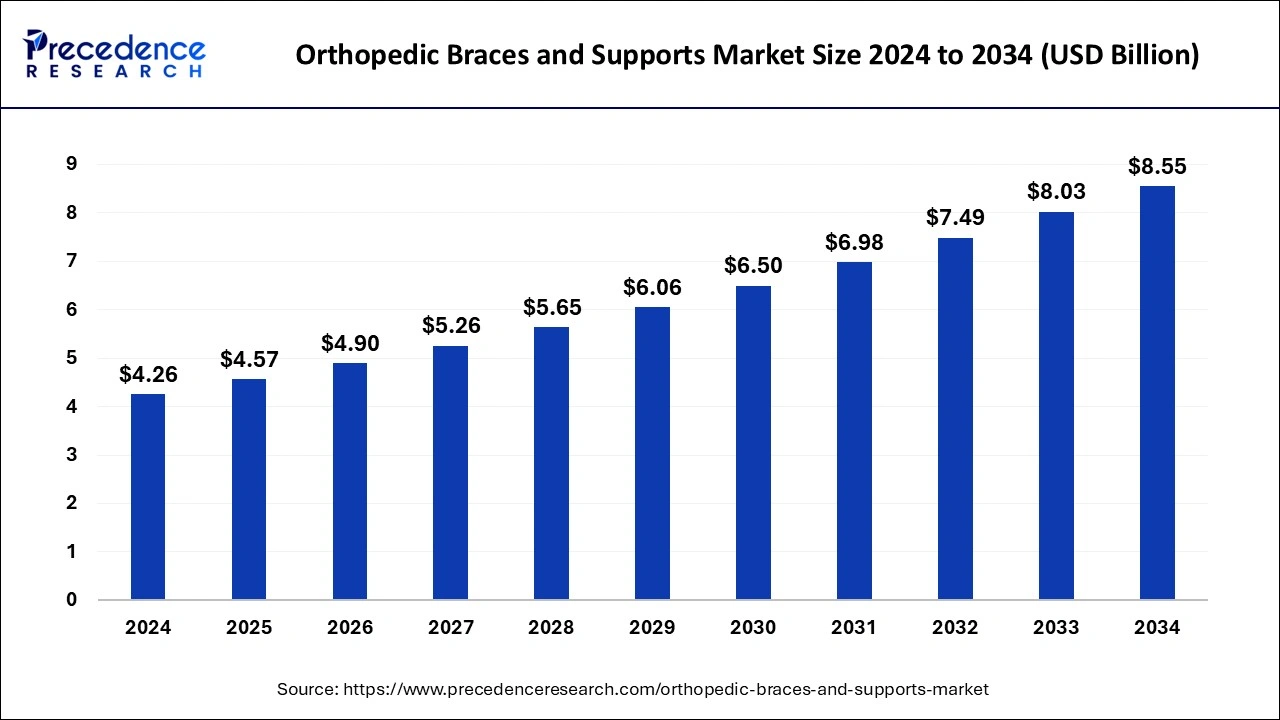The global orthopedic braces and supports market is set for rapid growth, climbing from USD 4.26 billion in 2024 to USD 8.55 billion by 2034, at a strong CAGR of 7.22%. This makes it one of the fastest-evolving segments in medical devices, driven by an aging population, sports injuries, and breakthrough technologies in wearable healthcare.

Healthcare providers, MedTech innovators, and consumer brands are embracing this momentum, particularly in North America and Asia-Pacific, where demand is strongest. Smarter product launches and AI-powered personalization are expected to reshape rehabilitation and preventive care.
Orthopedic Braces and Supports Market Key Highlights
-
Market Size: USD 4.26 billion (2024) → USD 8.55 billion (2034)
-
North America: Largest market with ~42% share, led by the U.S.
-
U.S. Growth: USD 1.25 billion (2024) → USD 2.65 billion (2034), CAGR 7.8%
-
Top Products: Knee and ligament braces dominate; soft and elastic braces lead sales.
-
Asia-Pacific: Fastest-growing region, supported by aging demographics and rising chronic disease rates.
How AI is Reshaping Orthopedic Braces
Artificial intelligence is transforming the market in three major ways:
-
Personalized Fit: AI-powered design tools allow braces to be customized for pressure, adjustability, and comfort, improving recovery outcomes.
-
Smart Monitoring: Sensors embedded in braces track patient movement, enabling real-time adjustments and dynamic therapy.
-
Operational Efficiency: AI supports doctors and retailers with product recommendations, compliance monitoring, and automated inventory management.
These advances are moving orthopedic supports from static devices to intelligent wearables that adapt with the patient.
Key Growth Drivers
-
Demographic Shifts: Longer lifespans and higher musculoskeletal disorder rates increase demand.
-
Sports Participation: Youth and professional sports drive ligament and joint injury cases.
-
Tech Innovation: Adjustable, lightweight, and wearable-enabled braces enhance patient comfort.
-
Insurance & Access: Expanded coverage and e-commerce boost global adoption.
-
Direct-to-Consumer: Off-the-shelf and digital platforms improve affordability and reach.
Opportunities and Trends
-
Cost Pressures vs. Innovation: R&D is making braces more affordable, while premium smart solutions target urban consumers.
-
Consumer-Centric Design: Lightweight, skin-friendly, and connected devices reflect rising demand for preventive and rehab-focused products.
Regional Insights

North America
-
Largest market (~42% share in 2024).
-
Growth fueled by advanced healthcare systems, insurance support, and major MedTech players.
-
U.S. braces market forecast: USD 1.25 billion → USD 2.65 billion by 2034.
Europe
-
Second-largest market, driven by an aging population and high surgical volumes (e.g., Germany’s 17.2 million surgeries in 2019).
-
Strong R&D focus and regulatory standards in countries like France support innovation.
Asia-Pacific
-
Fastest-growing region with rising healthcare spending in India, China, and Japan.
-
Aging demographics, obesity, and chronic disease rates drive demand.
-
Online and offline distribution channels make braces more accessible.
Orthopedic Braces and Supports Market Segmentation
-
By Product: Soft and elastic braces dominate for comfort and adjustability.
-
By Application: Ligament injury braces lead demand, fueled by sports injuries and accident-related cases. Preventive care and osteoarthritis solutions are also growing rapidly.
Orthopedic Braces and Supports Market Companies
-
Ossur
-
BREG, Inc.
-
DeRoyal Industries, Inc.
-
Bauerfeind
-
Ottobock
-
Fillauer LLC
-
McDavid
-
Hely & Weber
Case Spotlight: Origami-Inspired Personalized Wrist Orthosis
The Problem
Traditional wrist braces often force a compromise:
-
Too rigid → restricts dexterity.
-
Too flexible → reduces support, risking reinjury.
Patients with carpal tunnel, wrist injuries, or post-surgical needs often find braces uncomfortable and poorly adapted to recovery stages.
The Innovation
Researchers designed a Kresling origami-inspired wrist orthosis with foldable fabric panels and tendon-like actuators, enabling six motion modes (flexion, extension, radial/ulnar deviation, pronation, supination).
Why It Matters
-
Adaptive Recovery: One device shifts from immobilization to assisted mobility.
-
Improved Comfort: Lightweight, fabric-based design enhances wearability.
-
Dexterity Retention: Patients maintain functional movement during rehab.
-
Cost Savings: A single adaptable brace replaces multiple devices.
Applications
-
Post-surgery rehab
-
Sports injuries
-
Chronic conditions (arthritis, repetitive strain)
-
Elderly care
This breakthrough shows the future of orthopedic care lies in adaptive, dynamic, patient-centric support systems combining biomechanics, soft robotics, and wearable tech.
Read Also: Biopharmaceutical Packaging Market
Download Free Sample Report: Precedence Research